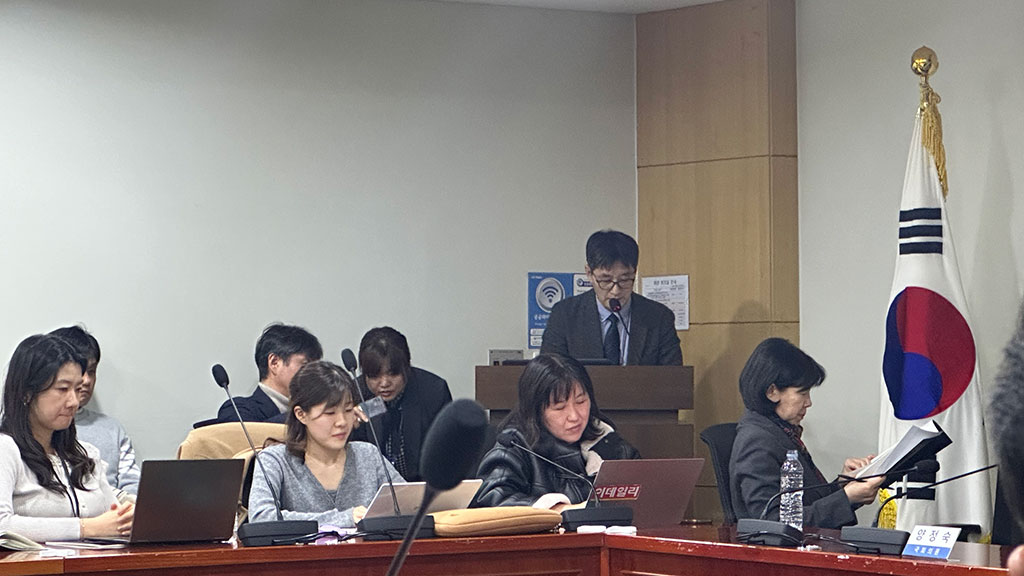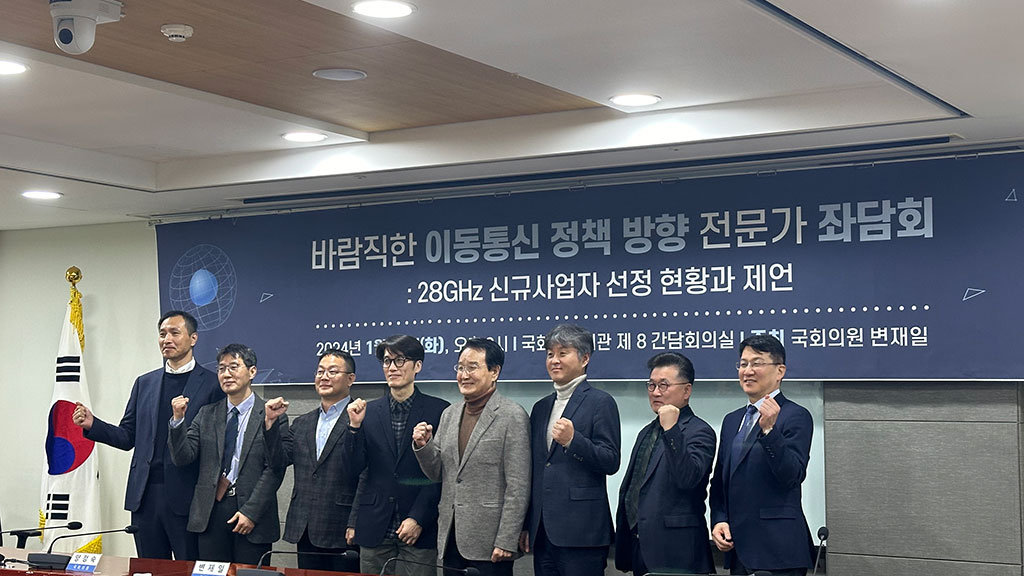과기부의 통신시장 경쟁촉진 방안의 기조 아래 추진되고 있는 5G 28GHz 신규사업자 발굴을 두고 일부 전문가들이 회의감을 표했다. 이통3사가 손을 놓은 28GHz 사업의 활성화를 달성할 수 있을 것이라 기대감이 존재하는 반면 통신시장 경쟁촉진 당초 목표의 달성 가능성 의문을 해소하기 위한 안전장치 마련의 필요성이 대두되고 있다.
과기부, 28GHz 신규사업자 대규모 투자 추진
“28GHz 사업 실패 우려…재정 능력 중요”
소비자 납득 위한 제4이통 구체적 계획 확보 必
과기부의 통신시장 경쟁촉진 방안으로 추진되고 있는 5G 28GHz 신규사업자 발굴을 두고 일부 전문가들이 회의감을 표했다. 5G 28GHz 활성화에 대한 기대감과 동시에 통신시장 경쟁촉진 당초 목표의 달성 가능성 의문을 해소하기 위한 안전장치 마련의 필요성이 대두되고 있다.
더불어민주당 변재일 국회의원 주최 ‘바람직한 이동통신 정책 방향 전문가 좌담회 : 28GHz 신규사업자 선정 현황과 제언’가 국회 의원회관 제8간담회실에서 16일 열렸다. 해당 좌담회에는 좌장 동국대 이경원 교수와 토론회 패널로 민주당 정책위원회 안정상 수석전문위원, 연세대 모정훈 교수, 한양대 신민수 교수, 순천향대 관규태 교수, 서울YMCA 시민중계실 한석현 실장, 과기부 통신정책기획과 마재욱 과장이 참석했다.
좌담회에 앞서 지난해 7월 정부는 ‘통신시장 경쟁촉진 방안’ 발표 후, 28GHz 대역 활성화와 통신시장 경쟁구조 개선을 위해 지난해 말 5G 28GHz 주파수 할당 신규 통신사업자를 모집했다. 현재 세종텔레콤, 스테이지파이브, 미래모바일이 주파수 할당 신청 적격여부 결과 ‘적격’ 판정을 받고, 1월 25일부터 경매를 앞두고 있다. 경매 후 선정된 신규사업자는 주파수 할당대가 인하, 망 구축 의무 경감, 로밍·설비 제공 등 최대 4천억원의 대규모 정부 지원을 받는다.
■ 28GHz 신규사업자, 바람직한 방향은
이날 토론회에서 전문가들은 신청기업의 재정 능력을 이유로 신규사업자의 시장 성공 가능성에 부정적 의견을 제기했다. 연세대 모정훈 교수는 “이동통신 사업 초기 대규모 망 구축 비용, 마케팅 비용이 필요한데, 재정 역량이 부족할 경우 사업성을 획득하기는 어려울 것”이라고 말했다. 신규사업자가 받는 정부의 수혜를 ‘비대칭 규제’라 칭하며, 신규사업자의 자생적인 역량을 갖출 방안을 마련해야 한다고 덧붙였다.
순천향대 곽규태 교수는 2019년 등록제로 개편된 현행 신규사업자 진입제도에 허점이 있다고 꼬집었다. 신규사업자에 대한 제반 우려가 제기될 수 있어 ‘주파수할당 조건’에 제도적 보완을 더해야 한다고 주장했다.
이 같은 논란은 신규사업자가 28GHz 기반 서비스를 운용한다는 데에서 논란이 빚어진다. 업계 전문가들은 28GHz 대역 주파수 특성 자체는 B2C 서비스를 하기에 어려운 대역으로 판단하고 있다. 이미 이통3사가 실패한 5G 28GHz 대역에 대한 킬러 콘텐츠도 없을 뿐더러 특화망 사업자와의 차이가 모호하다는 지적이다.
서울 YMCA 시민중개실장은 “정부는 28GHz 활성화라는 1차 목적을 위해 신규사업자를 수단으로 활용하고 있으며, 28GHz 실패를 신규사업자로 만회하려는 의도”라고 말하며, 정부는 신규사업자의 28GHz 정책 적정성 평가를 투명히 할 필요를 제시했다. 민주당 안정상 정책위원회 수석전문위원은 “실질적인 사업 투자를 지속하기 위해 재정 능력 검증하고, 경매일자를 연기하는 것도 고려해야 한다”며 강력히 반발했다.
또한 신규사업자와 알뜰폰 정책이 상충할 수 있다는 문제도 제시됐다. 신규사업자는 현재 28GHz 전국망이 없어 로밍 등을 이용해 서비스를 병행하게 되는데, 알뜰폰보다 혜택이 큰 경우 요금 경쟁이 심화될 수 있다는 우려를 해소해야 한다는 의견이다.
■ 이미 던져진 주사위, 주파수의 행방은

주파수 경매 일정 연기와 같은 요구에도 불구하고 현재 정부의 입장은 공고해 보인다. 과학기술정보통신부 마재욱 통신정책기획 과장은 이날 토론회에서 고착화된 통신시장의 구조를 변화를 통한 가격 및 서비스 경쟁 촉진의 필요성을 제고했다.
마 과장은 “2016년부터 신규사업자 참여를 위해 거듭되며 정책을 완화했지만 번번이 실패했다. 그러나 이 때문에 국내 이통사가 3개로 고착화돼 활력이 떨어지고 가격, 서비스 면에서 더 이상 경쟁이 일어나지 않아 구조를 바꿔야 한다”고 주장했다.
한편 신청기업 적격 판정 시 재무 능력 검증 절차는 다수 생략됐으며 신규사업자가 핫스팟 지역에서 28GHz 서비스를 하고, 이후 전국망 서비스를 요청하는 경우 sub-6 대역을 제공한다는 점에 대해서는 인정했다. 마 과장은 “경쟁력을 갖추면 이통3사에 견주는 제4이통이 될 것이라며, 공정한 절차를 거쳐 사업자를 선정했고, 사후에 정부가 할 일이 중요해졌다”고 말했다.
이를 두고 신청기업 관계자는 “원래 통신 사업이란 초기 정부의 대규모 지원을 받는 사업”이라고 주장했다. 또한 “중소기업이 정부의 투자를 받아 사업에 도전하는 것을 지적한다면 결국 대기업 위주로의 고착화는 피할 수 없을 것”이라 덧붙였다. 그러나 28GHz 대역뿐만 아니라 특화망과 로밍 등의 사업도 함께 병행할 수밖에 없다는 사실은 확실히 밝혔다.
통신시장 경쟁 활성화라는 기조에는 모두 공감하는 가운데, 정부는 신규사업자의 목적을 분명히 해야 할 것으로 보인다. 지난 2018년 정부는 이통3사에게 3.5GHz 대역과 함께 28GHz 주파수를 5년 지원했지만 이통3사 모두 상용화에는 실패했다. 결국 대기업도 포기한 28GHz 대역을 사업을 상용망에 적용하는 데는 무리가 있는 상황이라고 모두 전문가들은 동의했다.
이에 따라 정부는 제4이통의 역할과 관련 정책을 소비자들에게 투명히 공개하고, 이동통신 경쟁을 촉진할 수 있는 지원 가능한 부분부터 개선할 필요가 있어 보인다. 예컨대 5G 3.5GHz 대역 전국망 보급 100% 완료, 5G 특화망 28GHz 대역 지원 확대, 알뜰폰 지원방안 검토 등이다.
제4이통에 대규모 투자를 지원하는 데 있어 통신비 부담을 경험한 통신 소비자들에게 투명하게 정책을 공개하지 않아 신뢰를 확보하지 못한다면 실질적 수요의 미흡으로 신규사업자 계획은 다시 실패로 돌아갈 가능성이 크다.
정부의 제4이통 지원에 대한 구체적인 계획이 미비하다면 기존 사업자와 신규사업자 간 갈등에서 정작 끝단에 있는 소비자는 국민 편익 보호 방안이라는 명목으로만 이용될 행색이다. 따라서 통신 요금을 목표한다면 알뜰폰과도 차별점을 두고 제4이통의 필요성을 납득시킬 수 있는 계획이 필수적으로 수반돼야 한다.

